Breeds of Sheep & Goat
Breeds of Sheep & Goat
Sheep breeds
Breeds of Sheep in different agro-ecological regions in India and their major products.
| North Temperate | North-Western Arid and Semi Arid | Southern Peninsular | Eastern |
| Bhakarwal (CW) Changthangi (CW) Gaddi (CW) Gurez (CW) Karnah (AW) Kashmir Merino(AW) Poonchi (CW) Rampur Bushair(CW) |
Chokla (CW) Hissardale (AW) Jaisalmeri (MCW) Jalauni (MCW) Kheri (MCW) Magra (CW) Malpura (MCW) Marwari (MCW) Muzaffarnagari(MCW) Nali (CW) Patanwadi (CW) Pugal (MCW) Sonadi (MCW) Munjal(M) |
Bellary (MCW) Coimbatore (MCW) Daccani (M) Hassan (M) Kanguri (M) Kilakarsal (M) Madras Red (M) Mandya (M) Mecheri (M) Nellore (M) Nilgiri (AW) Rammand White (M) Tiruchy Black (M) Vembur (M) |
Balangir (MCW) Bonpala (MCW) Chottanagpuri (MCW) Ganjam (MCW) Garole (M) Tibetan (CW) |
Within parenthesis is the major product of the breed. (AW), Apparel wool; (CW), Carpet wool; (MCW), Mutton and Carpet wool; (M), Mutton .
Indian sheep breeds
Mecheri- Distributed in Salem, Erode, Karur, Namakkal, and fewer parts of Dharmapuri districts of Tamilnadu.
- It is a meat purpose breed.
- Adult male average body weight 36kg.
- Adult female average body weight 22kg.
- This is distributed in Ramanadhapuram, Sivagangai and Thirunelveli districts of Tamilnadu.
- It is meat purpose breed.
- It is found in black red skin color.
- Black colored bands are found on the skin in the regions of head, stomach and legs.
- Tail is smaller and slender.
- Adult male goats are found with stronger coiled horns.
- Majority of the goats are found with wattle, under the jaw/throat.
- Adult male average body weight 29kg.
- Adult female average body weight 22kg.
- It is distributed in Vembur, melakarandhai, keezha karandhai, nagalapuram regions, Tuticorin and Virudhunagar districts of Tamilnadu.
- It is meat purpose breed.
- These are taller breeds with white color skin with red color spots over their body and ears are drooped out.
- Adult males are found with horns and absence of horns in case of females.
- Adult males average body weight 35kgs.
- Adult females average body weight 28kgs.
- These are distributed in Neelagiri district of Tamilnadu.
- It is wool purpose breed.
- Majority are found in white colors.
- Certain goats are found with purple spots on their body and face.
- Adult male average body weight 31kg.
- Adult female average body weight 31kg.
- These are distributed in Trichy, Perambalur, Dharmapuri and Salem districts of Tamilnadu.
- It is wool purpose breed.
- These are smaller breeds.
- Black coloured all over the body.
- Adult male average body weight 26kg.
- Adult female average body weight 19kg.
- It is distributed in Coimbatore district of Tamilnadu.
- It is wool purpose breed.
- Medium weighed animal.
- Found in white colors, with black or purple colored bands, seen over the regions of head and neck.
- Adult male average body weight 25kg.
- Adult female average body weight 20kg.
- Deccani breed is an admixture of the woolly types of Rajasthan and the hairy types of Andhra Pradesh and Tamil Nadu.
- It is found in Bombay-Deccan region and parts of Karnataka and Andhra Pradesh States.
- The sheep is small and hardy, and well adapted to poor pastoral conditions.
- It possesses a coloured fleece, black and gray colours being more dominant.
- The average annual yield of wool being 4.54 kg per sheep.
- The wool is of a low grade and is a mixture of hair and fine fibres, mostly consumed for the manufacture of rough blankets (Kambals).
- The flocks are maintained chiefly for mutton.
- It is distributed in Nellore, Prakasam and Ongole districts of Andhra Pradesh.
- They are tall animals with little hair except at brisket, withers and breech.
- Rams are homed ewes are polled.
- Males have average body weight of 36 kg and female have 28 kg.
- Nellore is the tallest breed of sheep in India, resembling goats in appearance.
- The majority of the flocks are of fawn or deep red fawn colour.
- It is distributed in Mandya district of Karnataka.
- Relatively small animals colour white - sometimes face is light brown which may extend up to neck.
- Adult male weighs 35 kg and female weighs 23 kg.
- Best mutton type conformation among the Indian breeds.
- Sheep are hardy, yielding coarser carpet variety white wool of a mixed hairy composition.
- The sheep are found all over Jodhpur and parts of Jaipur districts.
- Flocks are raised in Pali and Barmer districts.
- The animals migrate to distant places in Uttar Pradesh, remote districts of Madhya Pradesh and sometimes to the northern parts of Maharashtra.
- The yield of wool per year is 0.90-1.81 kg per animal.
- Sheep are small in size, and are found in Kishtwar and Bhadarwah tehsils of Jammu.
- A large number inhabit the Kulu valleys in HP winter, and in summer they graze the highest elevations of them Pir Panjal Mountains, mostly in the Paddar range.
- Rams are horned, ewes hornless; fleece is generally white with brown coloured hair on the face.
- Wool is fine and lustrous; average annual yield is 1.13 kg per sheep, clipped thrice a year.
- Undercoat is used for the manufacture of high quality Kulu shawls and blankets.
Balangir

Origin of Balangir Sheep: The Balangir breed of sheep is native to the north western districts of Balangir, Sambalpur, and Sundargarh in Odisha. They are medium-sized animals, white or light brown or of mixed colours. A few animals are also black. The ears are small and stumpy. ... Breeding is primarily pure.
white or light brown or of mixed colours. Medium sized animals. Few animals are also black. The ears are small and stumpy. Tail is medium long and thin. Fleeceis extremely course , hairy and open. Legs and belly are devoid of wool. Horns are found in male only..
Bellary

- The Bellary sheep breed is native to the districts of Bellary and Davanagere and the adjoining areas of Haveri and Chitradurga districts of Karnataka. This breed of sheep has excellent demand in Karnataka area and border of Telanagna, Tamilnadu. This breed is preferred and raised for meat purpose.
- Body colour ranging from white through various combinations of black and white Strong built and medium sized animals. Ears are medium long, flat and drooping. Horns are found in 30% male only
Bhakarwal
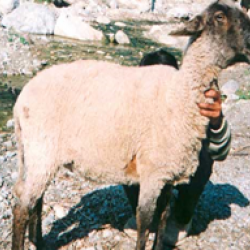
- Bakharwal breed derives its name from the rearing of sheep which is a nomadic tribe. The Bakharwal sheep are entirely migratory and have no distinct home tract. They may be found in the Pir Panjal ranges of the Jammu division during winter and migrate to the Kashmir Valley during summer.
- The animals are generally white, although coloured fleece are occasionally observed. Medium-sized animals, with a typical roman nose. All animals are spotted fawn orgrey. Rams are horned; ewes are polled. Ears are long and drooping. Tail is small and thin. Fleece is coarse and open.
Bonpala

Bonpala sheep have mixed colours ranging from all white, white and black or all black. Tall, leggy, well-built animals. Ear sare small and tubular.Tail is thin and short.Fleece is course hairy and open. Belly and legs are devoid of wool.
Chevaadu

- Two colour variant vizare Light brown & Dark Brown or tan are present. Hornsare curved horizontally outward, backward with blunt conical apex having few thick ridges. Horn is light brown in colour. Horns are curved horizontally outward, backward with blunt conical apex having few thick ridges. Horn is light brown in colour.
Chokla

Light to medium-sized animals.Face generally devoid of wool, dark brown and the colour may extend up to the middle of the neck. Head profile is straight. Ears small to medium in length and tubularrelatively fine.Tail thin and medium length. Coat colour is white, dense, relatively fine, covering the entire body including the belly and greater part of legs.
Chottnagpuri
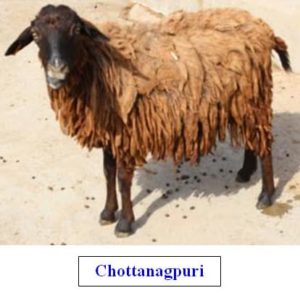
Animals are small, light in weight with light grey and brown colour. Ears are small and parallel to the head. Tail is thin and short. Fleece is coarse, hairy and open and is generally not clipped.
Garole

Compact and square body with small head, medium ears and short and thin tail. Grey and white are predominant colour in this breed. The udder is fairly developed and twins can easily be sustaine donthe milk available from the ewes. Fleece is open,coarse and very dense.Multiple births are common.
Gurez

Largest of the sheep breeds in J&K. Generally white, although some animals are brown or black or have brown or black spots. Tail is thin and short. Fleece is generally coarse and hairy. Ears are long, thin and pointed.
Hassan
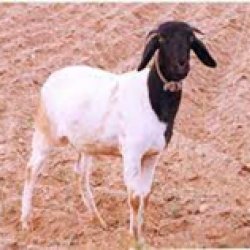
- The Hassan breed of sheep as the name suggests is traditional to the Hassan district of Karnataka. They are small to medium animals and have a white body with light brown or black spots. The ears are medium-long and drooping, 39% of the males are horned; females are usually polled.
- Small animals.White body with light brown or black spots. Ears are medium-long and alert. Fleece is white, extremely coarse and open ; legs and belly are devoid of wool.
Jaisalmeri

- The name of the Jaisalmeri breed is derived from its home tract, Jaisalmer. They are distributed across the Jaisalmer, Barmer and Jodhpur districts of Rajasthan. ... Age at first breeding is 15-18 months for rams and 12-15 months for ewes. Lambing percentage is about 55 to 60. Litter size is usually single.
- Animals are fairly built square,deep and tall in appearance. Black or dark brown face, the colour extending upto the neck. Typical roman nose. Long drooping ears, generally with acartilaginous appendage.Both sexes are polled. The tail is medium to long.The fleece is white, of medium carpet quality and not very dense.
Jalauni

Medium sized animals, with astraight nose line. Ears are large flat and drooping.Tail is thin and medium in length. Fleece is coarse, short-stapled and open, generally white. Belly and legs are devoid of wool.
Kajali

Kajali sheep has two types /colour variants: Black (Kali) and White (Chitti) Kajali. Black Kajali have complete black or black-brown or brown body. White Kajali have complete white coat with black or dark brown circle/patch around the eyes, and in face and ears. These sheep have roman nose, long and pendulous ears, and long tail touching the ground (about 55cm)
Karnah

Medium sizes animals with round and compact body.The rams have large curved hornswith pointed tip sanda prominent nose line (roman nose).The predominant coat colour is creamy white.Ears are pendulous and medium.Tail thin, straight and medium.
Katchaikatty

Animals are medium in size with compact body and are black in colour. Coat type is hairy. The breed is reared for meat and manure. Rams are well known for fighting.
Kendrapada

- Kendrapara sheep is an indigenous variety mainly found in Kendrapara, Cuttack, Jagatsinghpur, Bhadrak and Jajpur districts of Odisha. The Kendrapara breed was identified as the second in India and sixth in the world to carry FecB mutation gene responsible for multiple births such as twins and triplets.
- These sheep are mostly brown in colour, Button type horns in few males. Face, Belly and legs are bare. Rest of the body is covered with Non-Lustrous hair, Animals have horizontal ears; short, Straight and drooping tail.
Kenguri

Medium sized animals.Body colour is mostly dark brown or coconut colored, but colours ranging from white to blackwith spots of different shades are also observed. Ear sare medium long and drooping. Tailis short and thin.
Madras Red

- The Madras Red Sheep is an indigenous breed of sheep native to the northeastern parts of Tamil Nadu (Chennai, Kancheepuram, Tiruvellore, Villupuram and adjoining areas of Vellore, Cuddalore and Thiruvannamalai districts).
- Body colour is predominant brown, the intensity varying from light tan to dark brown ; some animals have white markings on the forehead , inside the thigh and on the lower abdomen. Ears are medium, long and drooping. The body is covered with short hairs
- Tail is short and thin
- Males are horned and ewes are polled.
- They are hardy and drought tolerant.
- Average body weights at birth, three, six and twelve months of age were 2.71, 9.97, 14.84 and 21.03 kg, respectively. Dressing percentage was around 49.
Magra

- The Magra sheep, also known as Bikaneri Chokhla or Chakri and formerly known as the Bikaneri, is a breed of sheep that is found in the Bikaner, Nagaur, Jaisalmer and Churu districts of Rajasthan, India. However, purebreds are only found in the eastern and southern parts of the Bikaner district.
- Medium to large animals.White face with light brown patches around the eyes, characteristic of this breed. Skin colour is pink. Ears are small to medium and tubular. Both sexes are polled. Tail is medium in length and thin. Fleece is of medium carpet quality, extremely white and lustrous and not very dense.
Malpura
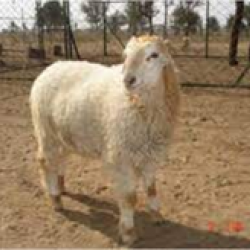
- Malpura is one of the important sheep breeds among 8 breeds available in Rajasthan. ... Malpura is a medium to heavy size breed, and on an average its adult body weight is 40 kg in males and 30 kg in females. In fanners' flocks birth weight ranged from 2.77 to 3.50 kg and 6 month body weight ranged from 16.4 to 18.94 kg.
- Fairly well-built animals with long legs. The typical colour of the face is light brown extending up to the neck. Ears are short and tubular, with a small cartil aginous appendage on upper side. Both sexes are polled. Tail is medium to long and thin. White fleece, extremely coarse and hairy. Belly and legs are devoid of wool.
Nali
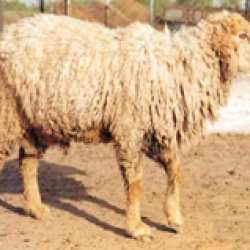
- The Marwari is an Indian breed of domestic sheep. It originates in, and is named for, the Marwar region of south-western Rajasthan, in the north-west of India.
- Medium sized animals.Face colour is light brown, skin colour is pink. Both sexes are polled. Ears are large and leafy(pendulous). Tail is short to medium and thin. Fleece is white,coarse,dense and long-stapled . Forehead, belly and legs are covered with wool.
Nilgiri

- Nilgiri sheep is a breed of sheep found only in Nilgiris district of Tamil Nadu State in India. It is bred in the hilly parts of Nilgiri and known for its fine wool. A national plan has been implemented to save the Nilgiri sheep from extinction by the National Bureau of Animal Genetic Conservation.
- Medium sized animals. Body colour is white ; exceptionally there are brown patches on face and body. Face line is convex giving a typical roman nose.Ear sare broad, flat and drooping. Males have horn buds and scars ; females are polled. The tail is medium and thin. The fleece is fine and dense.
Panchali

- Panchali is a dual purpose sheep reared for milk & meat in Panchal area of Gujarat. Animals are large in size, and have long legs and excellent migration ability. Coat color is white. Head or facial parts are black, blackish brown, brown and light brown in color. Ears are long and pendulous. Tail is long. Udder is well-developed. Milk yield ranges from 0.4 to 1.2 litre/ day. Animals attain 18 to 20kg body weight at 3 to 4 months of age. Adult weight varies from 53 to 82kg in males and 32 to 73kg in females. Wool is coarse and annual production is nearly one kg.
- Coat color is white. Animals are large in size, and have long legs and excellent migration ability. Head or facial parts are black, blackish brown, brown and light brown in color. Ears are long and pendulous. Tail is long. Udder is well-developed
Patanwadi

- Medium to large animals with relatively long legs. Typical roman nose. Face brown and spotted tan Ears medium to large tubular with a hairy tuft. Tail thin and short. Both sexes are polled.White fleece is of medium carpet quality ,notvery dense
Poonchi

- This sheep breed, as its name suggests, is native to the Poonch and Rajouri districts of the Jammu region of Jammu and Kashmir. ... The weight of the poonchi sheep adult ram ranges from 35 to 40 kg, that of a ewe from 25 to 30 kg. Weight of females at 2½ years: 27.64 ± 2.00 kg.
- Similar in appearance to Gaddi ,but lighter in weight. Animals are predominantly white, including the face, but spotted sheep are also seen , varying from brown to light black. Ears are medium long. Tail is short and thin ; legs are also short, giving a low-set conformation.
Pugal

- The name of the Pugal sheep breed originates from the Pugal tehsil of Bikaner district, which is the home tract of this breed. Pugal Breed Features: ... In farmers' flocks, age at first breeding for ewes is 15 months and for rams it is 18 months. The litter size is generally single.
- Fairly well-built animals. Black face with smalles on either side above the eyes lower jaw typically light brown. The black colour may extend up to neck. Ear sare short and tubular.Both sexes are polled. Tail is short to medium and thin. White fleece, of medium carpet quality, not very dense
Ramnad (Ramanadhapuram) White

- This is distributed in Ramanadhapuram, Sivagangai, and Virudhunagar districts of Tamilnadu.
- It is meat purpose breed.
- It has medium sized body.
- Majority of them are white in color. Some have black markings all over their body.
- Adult males have their bent horns, whereas females with absence of horns.
- The ears are medium size and directed out ward and down ward. Tail is short and thin.
- Legs are smaller and slender.
- Average body weights at birth, three, six and twelve months of age were 1.68, 7.31, 8.45 and 16.30 Kg, respectively.
Rampur Bushair

Medium- sized animals. The fleece ispredominantly white , with brown , black and tan also see non the fleece in varying proportions.The ears are long and drooping.The face is convex giving a typical roman nose. The fleece is of medium quality and dense. Legs, belly and face are devoid of wool.
Shahbadi

- Distribution/Origin: The Shahabadi sheep breed, is native to the erstwhile Shahabad (subsequently bifurcated into the Bhojpur, Rohtas and Buxar districts), Patna and Gaya districts of Bihar. Shahabadi Breed Features: They are medium sized leggy animals. The fleece colour is mostly grey, sometimes with black spots.
- Medium-sized leggy animals. The fleece colour is mostly grey, sometimes with black spots .Ears are medium sized and drooping. Tail is extremely long and thin. Fleece is extremely course, hairy and open. Legs and belly are devoid of wool.
Sonadi

- Sonadi is an important sheep breed of Rajasthan in the northwestern region. of the country. The breed was evolved in the farmers' flocks and is being. maintained since centuries owing to its characteristics of adaptation to the. physical environment and economics of animal farming in the area of its.
- Fairly well built, some what smaller than Malpura, with long legs.White or light brown face with colour extending to the middle of the neck. Ears are large, flat, drooping and generally have a cartilag in ousappendage.Tail is thin and medium in length. Both sexes are polled. Udder is fairly well developed. White fleece, extremely coarse and hairy. Belly and legs are devoid of wool.
Tibetan

- Tibetan sheep are medium sized animals, primarily white with a black or brown face. Often brown and white spots are also observed on the body. Both sexes are horned. The nose line is convex, giving a typical Roman nose. The ears are small, broad and drooping.
- Medium sized animals, mostly white with black or brown face; brown and white spots are also observed on the body. Thenose is convex, giving a typical roman nose.The ears are small broad and drooping.The fleece is relatively fine and dense. The belly face and legs are devoid of wool.
Tiruchi black

- These are distributed in Trichy, Perambalur, Dharmapuri and Salem districts of Tamilnadu. It is wool purpose breed. These are smaller breeds. Black coloured all over the body. Adult males are found with horns and females without horns.
- Small animals. Body is completely black. Ears are short and directed down and forward. Tail is short and thin. Fleece is extremely coarse, hairy and open.
Exotic sheep breeds
- Dorset
- Suffolk
- Merino
- Rambouillet
- Cheviot
- Southdown
Goat breeds
Indian goat breeds
Jamunapari
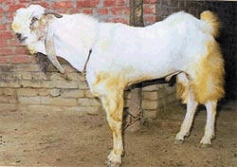
- Jamunapari breeds are found mainly in the state of Uttar Pradesh.
- Its coat colour is white with tan or black markings at neck and ears;
- This is largest and most elegant of the long-legged goats of India.
- It has pronounced Roman nose having a tuft of hair which results in parrot mouth appearance.
- Large sized goats, tall and leggy, with convex face line large folded pendulous ears.
- They are generally found in white colors.
- An adult female weighs between 45kgs to 60kgs, whereas an adult male ranges between 65kgs to 80kgs.
- Average birth weight up to 4 kg.
- Average age at first kidding is 20-25 months.
- They have large udder and big teats and average yield is 280 kg / 274 days.
- They having the ability to yield 2 to 2.5kgs of milk per day.
- The fat content of the milk ranges between 3 to 3.5%.
- Better milk yielding breeds are not found in Tamilnadu climatic conditions.
- They thrive best under range conditions with plenty of shrubs for browsing.
- Beetal breeds are found mainly in the states of Punjab.
- These breeds are grown mainly for the purpose of milk and meat.
- Generally smaller than the breeds of Jamunapari.
- An adult female goat ranges between 40kgs to 50kgs, whereas an adult male ranges between 50kgs to 70kgs.
- Age at first kidding 20-22 months.
- Average lactation yield 150 kg.
- They having the ability to give, 1kg to 2kgs of milk per day.
- Maximum yield being 591.5 kg in lactation period of 177 days.
- Coat Colour is predominantly black; red, tan or black, heavily spotted on white also occur;
- Average birth weight 3 kg.
- Popular in urban areas popular in urban areas of Delhi, Uttar Pradesh, Gurgaon, Karnal, panipat and Rohtak in Haryana state.
- These types of breeds are found mostly in the states of Delhi, Uttar Pradesh and Haryana.
- Barbari breeds are grown mainly for milk and meat purpose.
- The color of this breed is a mixture of white and purple.
- An adult female goat weighs between 25kgs to 35kgs, whereas an adult male goat ranges between 35kgs to 45kgs.
- They having the ability to give 1kg to 1.5kgs of milk per day.
- These types of breeds have better reproductive capabilities.
- They will give, 2 to 3 kids in parturition.
- They are usually stall-fed and are reported to yield 0.90-1.25 kg of milk.(fat content 5%) a day in a lactation period of 108 days..
- They are prolific breeder and kid twice in 12-15 months.
- This type of breeds usually kids twice, at an interval of 12 to 15 months.
Tellicherry

- Tellicherry breeds are also called as malabari breeds.
- These types of breeds are found mostly in the state of Kerala.
- They grown mostly for the purpose of meat.
- An adult female ranges in weight from 30 to 40kgs, whereas an adult male ranges between 40 to 50kgs.
- They can yield 1kg to 2kgs of milk per day.
- These types of breeds have better reproductive capabilities.
- They can give, 2 to 3 kids in a parturition.
- This breed grown in Tamilnadu, having the ability to yield one or two kids.
- Coat colour is brown, white, and admixture of colours in typical patches; hair coarse and short.
- Average body weight of buck 50 and doe 23 kg.
- Average birth weight 2.0 kg.
- Kidding is once a year, twins are common.
- Average age at first kidding 19 months.
- Average lactation yield 71 kg.
- Average lactation length 175 days.
- Coat colour is predominantly black; white, brown and spotted occur.
- Average birth weight 2.4 kg.
- Kidding is once a year.
- Average age at first kidding 19-20 months.
- It has good quality meat.
- Good yielders produce up to 3.5 kg a day.
- Average milk yield 170-180 kg per lactation.
- It is native of north Kerala.
- Coat colour varies from white to complete black; black and white, black and brown, and white with coloured patches occur;
- Average, buck live weight 39kg and doe 31 kg;
- Average birth weight 1.6 kg.
- Kidding is once a year, twins and triplets;
- Average litter size 2.1; average age at first kidding 19- 21 months.
- Average quality meat.
- Average yield is 0.9-2.8 kg of milk a day.
- Average milk yield 65 kg/lactation.
- Average lactation length 172 days.
- It has good quality skin.
- These are the tallest goat breeds found in the Thirunelveli and Ramanadhapuram districts of Tamil Nadu.
- Black or white spots in the black background are the characteristics colors of this breed.
- They are usually grown for meat purpose.
- The adult females of this breed ranges from 25kgs to 30kgs and the adult males’ ranges from 35kgs to 40kgs body weight.
- They grow well in the drought regions. Hence, this breed well suits for our country.
- These breeds are taller and found with different colors.
- They usually gave birth to one or 2 kids.
- They are usually grown for the purpose of guiding the goat flocks, which goes for grazing.
- These types of breeds are mostly found in the districts of sivagangai, ramanadhapuram, and tuticorin districts of Tamil Nadu.
- This black coloured breed, well suits for Tamil Nadu.
- Coat colour is predominantly black, brown/grey and white with soft, glossy and short hairs.
- Dwarf in body size
- Average live weight of buck 15 kg and doe 12 kg.
- Most prolific among Indian breeds.
- Multiple births common, two, 3 or 4 kids born at a time.
- Kidding twice a year. Average litter size 2.1.
- Average age at first kidding 9-10 months.
- Average lactation yield 53 kg. Lactation length 90 to 120 days.
- Its skin is great demand for high class shoe-making.
- Coat colour is predominantly white but greyish red and mixed colours seen.
- Average buck live weight 39 kg and doe 26 kg.
- Average birth weight 2.0 kg.
- Kidding is once a year and mostly single.
- Average lactation yield 69 kg and lactation length 187 days.
- Used for draught to carry salt and small loads.
- Long hair below which under coat of delicate fibre (cashmere or pashm).
- Used for draught (pack) to carry salt and small loads.
- Predominantly white and rest brown, grey and black. Undercoat white/grey; yields warm delicate fibre, pashmina (cashmere, pashm).
- Body and legs are small size, strong body and powerful legs.
- Average live weight of buck 20 and doe 20 kg; average birth weight 2.1 kg.
- Kidding is once a year, normally single;
- Average age at first kidding 20 months.
Ben Manenti

- Colour: Assam Hill goats are mostly white with occasional black patches on backline and legs.
- Horn shape & size: Both buck and does are bearded and have short cylindrical horns which are directed upwards and outwards. Ears are medium in size, horizontally placed with pointed tips.
- Visible characteristic: These goats are short legged with small body size.
Attapady

- Colour : Black
- Horn Shape & Size : Curved and oriented backwards. Small in size
- Visible Characteristic : Extremities are black. Tail is bunchy type.
Berari

- Colour: Light to dark tan(Reddish colour)
- Horn Shape &Size:Flat, small, oriented upward and backward
- Visible Characteristic :Black coloured ring around neck in adult male. Black hair line along with the vertebral column extending up to tail in both sexes.
Bhakarwali

- Colour: White and Black. Face or hindquarters are black in some animals. Pure black goats are also found. Whole-body is covered with long hair.
- Horn shape & size: Horns are screw type and are carried upwards and backward.
- Visible characteristic:These are large-sized goats having a convex head. Ears are cut and pendulous.
Bidri
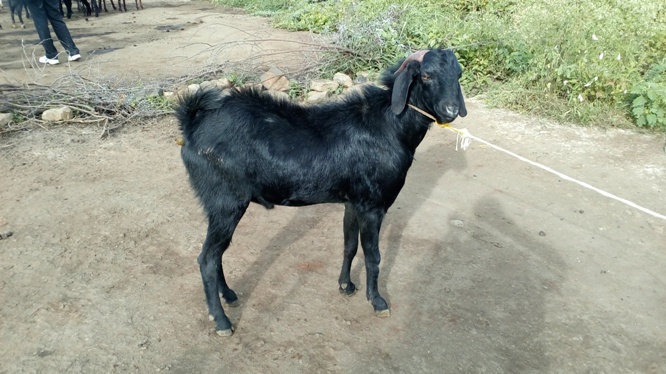
- Colour: Black . Muzzle, eyelids and hooves are black.
- Horn sape & size: Horns are present and are directed backward, outward and downward.
- Visible characteristic:Ears are pendulous.
Ganjam

- Colour : Black or Brownblack. White, brown and spotted animals are also found.
- Horn Shape & Size: Twisted and curved. Long, parallel and pointed backward and upward.
- Visible Characteristic : Males usually have beards. Head convex, ears are pendulous and medium in size (14.50 cm), wattles mostly absent.
Gohilwadi
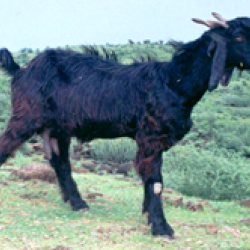
- Colour : Black
- Horn Shape & Size: Horns are slightly twisted and turned backward. Horns are 8 to 10cm long in female and 12cm to 15 cm in males.
- Visible Characteristic : Nose line is slightly convex. Ears are tubular and drooping. Body covered with coarse long hairs.
Jakhrana

- Colour: Predominantly black with white spots on ears and muzzle.
- Horn Shape & Size: Broad and flat , going backwards
- Visible Characteristic : Straight faceline. Forehead is narrow and slightly bulging. Udder size is large with conical teats.
Kahmi

- Colour: Coat color is unique – neck and face are reddish brown while rear abdominal part is black, locally called Kahmi.
- Horns shape & size: Horns are directed upwards and backwards.
- Visible Charactertic: Ears are long, tubular & coiled, locally called veludi. Wattles are present in majority of goat. Forehead is convex.
Konkan Kanyal

- Colour: Black with white marking on collar,lower jaw and ventral surface.
- Horn Shape&Size: Cylindrical, backward and medium in size (15-25 cm).
- Visible Characteristic:Bilateral whitestrips from nostrils to ear. Legs-long, laterally black, medially white and white from knee to fet lock joint. Tail-dorsally black and ventrally white
Kutchi

- Colour : Coat / body is predominantly black but a few white, brown and spotted animals are also seen
- Horn Shape & Size: Horns are short (10.6 cm), thick and pointed upwards.
- Visible Characteristic: Long and coarse hair, slightly roman nose, and short and thick horns.
Mehsana

- Colour: Black with white ear base.
- Horn Shape & Size: Screw type. Twisted slightly, curved upward and backward and pointed at the tips. 12-15 cm in males and 8-12 cm in females.
- Visible Characteristic :Ears have white spots ranging from a few white spots to complete white with few black spots at the base. White spots are present on the upper part of upper muzzle and look like a ring in some of the animals. Hair coat is long and shaggy.
Pantja

- Colour: Mix of light brown & white in females and males are mix of white
- Black Horn Shape & Size : Straight oriented backwards. Small in size
- Visible Characteristic :Long hairs on thigh region, straight horns. Goats are well adapted to humid condition of Tarai region.
Rohilkhandi

- Colour: Coat colour is predominantly black with star or patch on neck and face in some animals.
- Horns shape & size: Majority of animals are horned which are curved, and directed laterally and outwardly.
- Visible Charactertic: Beard and wattles are absent in both sexes. Forehead is slightly convex. Tuft of hair (black or brown) is present in thigh region. Tail is bunchy.
Salem Black

- Colour : Black .
- Horns shape & Size: Both males and females have horns that are medium in size, curved upwards and backwards.
- Visible Characteristic: These goats are tall, lean and leggy. Ears are medium, semi-pendulous having leaf-like appearance. In males, neck is thick, broad and well placed
Sangamneri
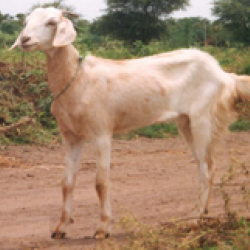
- Colour: White, black or brown. Spotted animals are also seen.
- Horn Shape & Size: Horns are directed backward and upward. Average length of horns is 12.36cm
- Visible Characteristic : Hair coat is extensively coarse and short.
Surti

- Colour: Mostly White.
- Horn Shape & Size: Directed backward. Small in size(about 12 cm).
- Visible Characteristic : Medium sized ears. Well-developed udder with large conical teats.
Zalawadi

- Colour: Body is covered with black, lustrous,Shining hairs. Some animals have white or brown hairs.
- Horn Shape & Size: Horns are cork-screw type moving straight upwards,backwards and slightly outward with pointing tips.
- Visible Characteristic: Long, wide leaf like and drooping ears. Well-developed udder with large conical teats.
Exotic goat breeds
- Saanen
- Alpine
- Anglo-Nubian
- Toggenberg
- Angora
- Boer
Sources:
- Expert System for Sheep & Goat, ICAR-TANUVAS-TNAU
- ICAR- Central Sheep and Wool Research Institute, Avikanagar
Related Resources
শেহতীয়া উন্নীতকৰণ: : 12/10/2021
This topic provides about *99# Service- Innovative...
This topic covers information related to Acute res...
This topic provides information about Zero tillage...
This topic provides information related to steps t...
